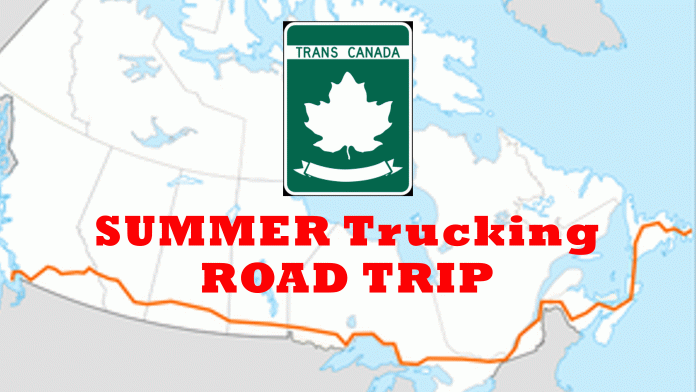The Trans-Canada Highway is the principal highway of Canada and Canada’s longest national road. It extends west-east between the Pacific and Atlantic coasts across the breadth of the country. When the Trans-Canada Highway first opened, it was almost exclusively a two-lane route for its whole length across the country. While at the time it was considered a major improvement to the gravel roads and ferries it replaced, it was soon believed to be insufficient to handle the growing traffic volumes. In response, several provinces began to construct realignments, freeway widening, and twin sections of highways in response to traffic flow and safety concerns. The TCH was born.
Canada’s main arterial network
| Province | Main articles |
| British Columbia | Highway 1 |
| Alberta | Highway 1 |
| Saskatchewan | Highway 1 |
| Manitoba | Highway 1 |
| Ontario | Highway 17 /417 |
| Quebec | Quebec Autoroute 40, Quebec Autoroute 20, and Quebec Autoroute 85 |
| New Brunswick | NB Route 2 |
| Nova Scotia | Highway 104 |
| Newfoundland and Labrador | Highway 1 |
Crossing our vast country each summer day is no easy feat. Apart from the breathtaking blend of natural beauty and vibrant cities filled with friendly people and great shopping. The Trans-Canada Highway is a road deserving respect and care as it traverses through both urban and rural areas, with only 3% being urbanized and 97% being natural and rural.
Where does it all begin? – Mile One
Mile One begins in St. John’s, Newfoundland and Labrador. Although there is no nationally sanctioned “starting point” for the entire Trans-Canada Highway system, St. John’s has adopted this designation for the section of highway running in the city. St. John’s downtown arena, Mary Brown’s Centre, was originally branded under naming rights as “Mile One Centre” in reference to the geography of the region. The foot of East White Hills Road in St. John’s, near Logy Bay Road, would be a more precise starting point of the highway, where the road meets and transfers into the beginning of the Trans-Canada Highway.
Where is Mile Zero?
There is a Mile Zero monument at the “start” of the Trans-Canada Highway in Victoria, British Columbia. The terminus of the Trans-Canada Highway in Victoria is located at the foot of Douglas Street and Dallas Road at Beacon Hill Park, and it is also marked by a “mile zero” monument.
Long Haulers
Working conditions for long-haul truckers are challenging and can give rise to safety issues. When drivers finally stop, they often try to rest in noisy truck stop parking lots during the summer or remote pullouts along the highway. They may or may not have regular access to food, restrooms, or showers. Furthermore, they spend extended periods of time away from their families, healthcare providers, and communities (sometimes up to 100 hours coast to coast). Limited access to healthy food poses real health implications for this line of work. Nevertheless, the opportunity to travel through the scenic beauty of the country in the summer makes the journey worthwhile. However, proper trip planning is crucial for a successful experience. Here are a few tips.
Trip Tips for long haul journey planning
| Estimating Time – Set methods for your time calculations | Probabilities? – speed, weather, traffic |
| Pick up and processing departure – trailer pickup and paperwork up to 2 hours |
| GPS (Global Positioning Satellite) – personal cell shows non trucking routes | use commercial phones |
| Trip itinerary– list drop centres | rest centres | fueling stations | |
| Dispatch – work on pre planning entire route, not per drop |
| Parking – arrive early | phone ahead | major centres may be space limited | arrange for private parking |
| Return Trip – consider it a new trip | plan tasks to improve 1st trip decencies | |
| Weigh Scales – consider yourself being checked each time add 1 hour |
| Drops & Pickups – call ahead for status | always min 1 hour | determine lay overs in advance |
| Fuelling – minimum ¼ tank always – allow for up to 1 hour fill – check DEF tanks every overnight stop |
| Loading Docks – call ahead for status | allow extra time for logistics | safety 1st a spill could kill |
Summer weather on the TransCanada
Driving almost 8,000 kilometers from coast to coast takes approximately 100 hours. The Trans-Canada Highway (TCH) stretches across Canada, covering a wide range of climates and weather conditions. Temperatures can vary between 20 and 40 degrees Celsius.
When driving west, the highway crosses the Rocky Mountains, and conditions there are generally pleasant during the summer. In the Prairies, conditions can range from hot to occasionally snowy. Currently, forest fires pose a significant challenge in some areas.
In the eastern part of the country, the highway passes through the Maritime Provinces. Winters in this region tend to be milder compared to the West. Summers can be hot and humid. Extensive forest fires are also a notable concern in this area.
Meeting the challenge
Long-haul trucking is not suitable for every truck driver. It demands extended periods of focused attention and being away from home for consecutive days. However, for certain individuals, the advantages outweigh the disadvantages. Regardless, consistently discovering high-quality loads amidst favorable summer weather can be an ongoing challenge. The Trans-Canada Highway (TCH) is continually evolving and requires a proficient, well-trained, highly skilled, and adequately compensated long-haul workforce. Are you ready for an abundant summer experience on the road?



















